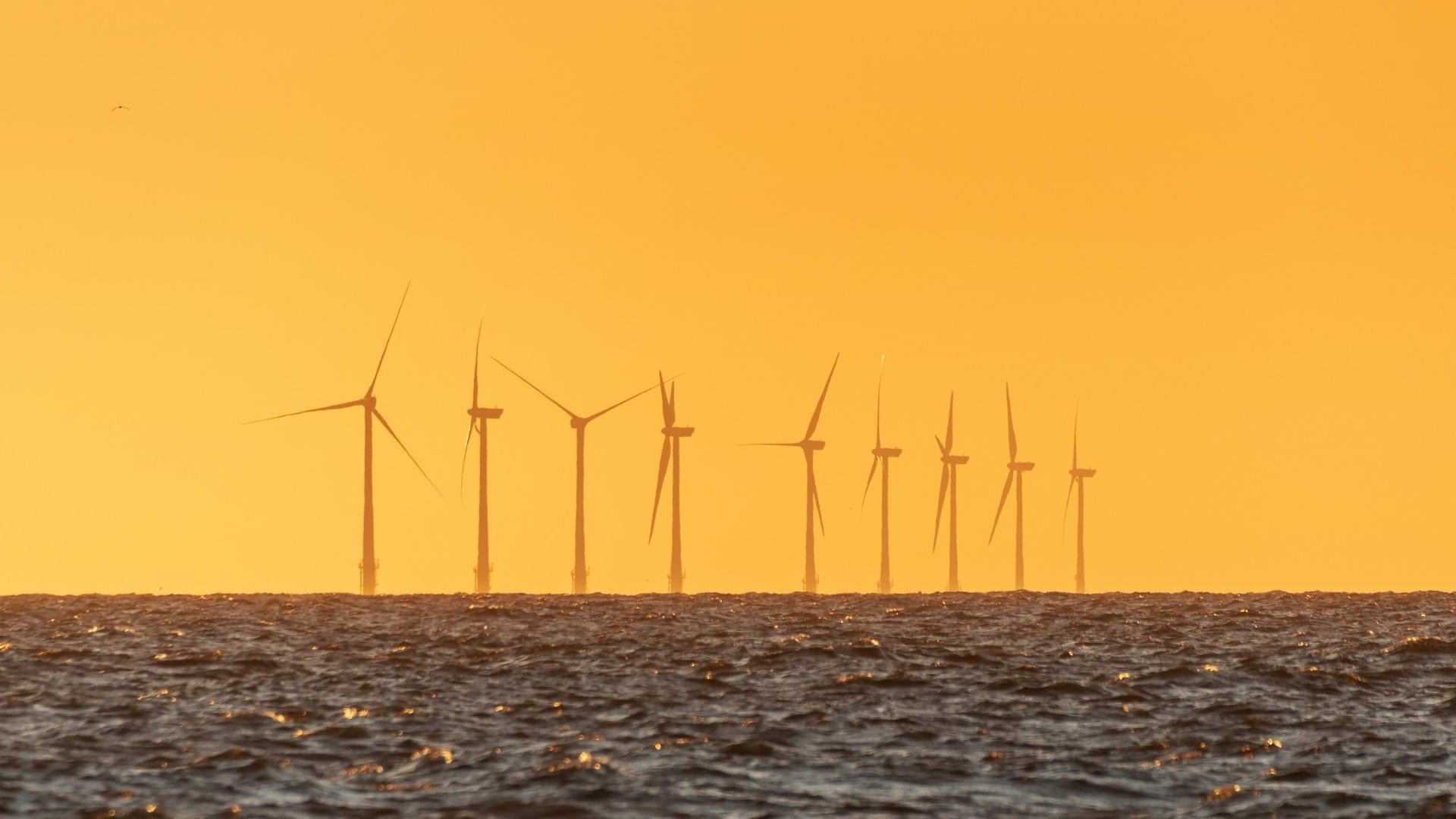Recent offshore wind projects and renewable wind zones announced in Victoria, New South Wales, Tasmania and Western Australia, illustrate the sector’s potential in Australia.
PwC estimates that based on the size of announced offshore wind zones in Australia, 23 gigawatts of offshore wind could be built by 2040 at a cost of $97.5 billion. Given the scale of the opportunity, the following are key points to consider:
- The economic opportunity is significant. Australia's GDP could be $40 billion higher between 2027 and 2040, and up to 19,000 jobs could be supported in the peak of construction.1 A further 7,000-14,000 jobs in operations provides new regional employment opportunities.2 These jobs will help to offset the forthcoming adjustment for the 10,000 workers in the domestic coal supply and coal fired power generation sector.3
- Being girt by sea, Australia has a mature marine and offshore sector already. Offshore wind developers can leverage these capabilities to provide the marine operations and installation services needed for construction. Opportunities are also present in turbine assembly, long-term operations and maintenance activities.
- Australia’s capital markets have growth opportunities. In partnership with overseas investors and export credit agencies, local debt and capital markets can support the financing of these investments.
- Governments have a key role to play. Through good policy selection, they can enable faster expansion and maximise the opportunity of the offshore wind sector.
This article outlines the scale of Australia’s offshore wind opportunity and how the country can make the most out of it.
There’s a roadblock in Australia’s energy transition challenge
The Paris climate accord is a binding agreement by the 194 signing nations to limit global temperature rises to 2 degrees Celsius. The transition to renewable energy sources creates unique challenges for every country. In Australia's case, one of these challenges is the geography of the National Energy Market (or, NEM), which is structured around existing baseload power and not well aligned to where renewable resources are strongest.
Australia has a promising boom in renewable energy generation investment, however the government’s planning delays are slowing expansion of the grid to the windy and sunny areas where it’s needed to serve new renewable projects. This is resulting in state governments delaying the closure of coal-fired power plants. The drive for Renewable Energy Zones (REZs) is aimed at resolving this issue, however the size of these projects result in their own risk of delay and cost overrun commonly associated with public-private partnerships. These issues will have a significant impact on Australia being able to achieve its target for renewable energy generation.
How can offshore wind help overcome this?
Australia’s features make offshore wind an appealing option for energy generation relative to land-based generation technologies:
- World class wind resources in New South Wales, Victoria, Tasmania, South Australia and Western Australia. In particular wind studies imply the Bass Strait has capacity factors in excess of 50%, compared to typical factors of ~30-35% for onshore wind.
- A transmission system focussed around the coastal load centres, and significant upcoming coal plant closures which may free-up existing transmission corridors
- A mature offshore thermal industry in Victoria and Western Australia that has many skilled workers and equipment with adjacencies to offshore wind
- A developing yet robust regulatory framework at the federal level in the Offshore Electricity Infrastructure Act 2021 (OEI Act) that also makes clear links to other existing legislation, which will be relevant for offshore wind (e.g. the Environmental Protection and Biodiversity Conservation Act 1999)
- Significant deepwater port infrastructure and development of adjacent shipbuilding infrastructure through the National Naval Shipbuilding Enterprise
- Significant capital markets such as the world's third largest superannuation system, searching for infrastructure investments with long-term annuity-like cashflows and a focus on sustainable products.
Funding offshore wind in Australia
Offshore wind is still a nascent industry in Australia, which on the surface has clear cost handicaps. The CSIRO GenCost report4 depicts midpoint offshore wind Levelised Cost of Energy (LCOE) estimates for Australia at ~$170/MWh, compared to ~$80/MWh for onshore wind. However, this ignores critical, whole-of-system considerations, namely the added generation diversity, proximity to coastal load centres and grid constraints that offshore wind can offer. Over 80 GW in offshore wind projects have been announced across Victoria, New South Wales, Tasmania and Western Australia. Of these projects, PwC’s offshore wind sector specialists estimate 23GW are likely to be built based on the size of the announced offshore wind zones.5
Given larger water depths off the coast of New South Wales in the proposed zones, these projects will require floating foundations. The remainder are assumed to be fixed. Using CSIRO data, we assume an average construction cost of ~$4.1m/MW6 for fixed and ~$4.7m/MW7 for floating, resulting in a capex requirement of ~$98billion over a 13 year period from 2027 to 2039.8
Table 1: Assumed pipeline of offshore wind projects in key Australian state
Cumulative GW installed by… |
Total assumed CAPEX ($bn) |
|||
|---|---|---|---|---|
2030 |
2035 |
2040 |
||
Victoria |
2.0 |
4.0 |
9.0 |
$36.9bn |
New South Wales |
0.0 |
3.0 |
6.0 |
$28.4bn |
Tasmania |
0.0 |
1.5 |
5.0 |
$20.1bn |
Western Australia |
0.0 |
1.5 |
3.0 |
$12.2bn |
Total |
2.0 |
10.0 |
23.0 |
$97.5bn |
Capex of this scale makes financing and bankability a critical issue, but also a significant opportunity for our capital markets. To put this in context, we have successfully built infrastructure at scale in regional and offshore locations across Australia before: the gas boom of the 2010s, where over $200 billion was invested,9 shows Australia can plan, fund and deliver large scale infrastructure investments.
The offshore wind sector in Australia will attract investors of various sizes and profiles, from large global fund managers to small or new developers with limited financial resources. Local lenders will need to familiarise themselves with the offshore wind sector and its risks and rewards, and may benefit from the participation of export credit agencies. Yet the sector will also require significant government incentives10 to create and grow the industry, following the example of other regions such as Europe.
Australia can also learn from Europe's "trial and errors" in managing construction risks for offshore wind. Europe's success in offshore wind has enabled new markets with limited access to established supply chains, such as Taiwan's first offshore wind farm Formosa 1. The financing of Formosa 1 was considered a landmark transaction, as the first project finance for offshore wind in Taiwan and the Asia-Pacific region. Financing was obtained from a consortium of eleven international and local Taiwanese banks and EKF Denmark’s Export Credit Agency, with European lenders dominating the international share.
The involvement of European banks in the financing of Formosa 1 reflects their expertise and experience in the offshore wind sector, as well as their interest in supporting the development of renewable energy in Taiwan and the Asia-Pacific region. The critical factor for Australia will be sponsors and project teams with experience in offshore wind or similar industries (i.e. offshore oil and gas), who can deal with the complex contracting structures and risks of this nascent industry.
Opportunities for Australian industries
The anticipation surrounding Australia's ‘local content’ potential (in other words, the opportunity for Australian industry to play a part in the supply chain) in offshore wind is evident. Our estimated pipeline of offshore wind projects, detailed in Table 1, foresees 23GW of installed capacity by 2040, with an associated capital expenditure of $97.5 billion. Against this backdrop, we pinpoint potential attainable local content opportunities in Australia, strategically aligning with existing supply chain capabilities and capacities (e.g. in onshore wind and adjacent oil and gas industries), in turbine assembly and marine installation.
Offshore wind turbine assembly
The assembly of offshore wind turbines presents one of the largest local content opportunities for the Australian workforce. Based on current supply chain capacity and capability, an estimated ~70%-80% of the assembly activities can be performed onshore - which may lead to $1.1b-$1.3 billion being invested locally in Australia.11
Marine installation
The establishment of offshore wind offers a promising opportunity for Australia's marine workforce for wind farm installation. Most of the key roles (~80%-90%) in this area can primarily be filled by Australian crews (with the exception of specialised technical positions). Potential local capital expenditure for marine installation, based on current supply chain capacity and capability, can range between $3.2b-$3.4 billion.11
Operations and maintenance
Post-build phase, opportunity for local industries lie in the 30 to 40 years of operations and maintenance of offshore wind farms - which is estimated to have an annual local spend across Australia of $1.3b-$1.5 billion.11 The spend is expected to be across labour, port and marine vessel operations, and parts for the turbine and balance of plant.
Other potential opportunities
Depending on the type of offshore wind solution (e.g. floating vs. fixed-bottom), component design (e.g. floating substructure, tower steel plates) and developer’s preferred suppliers (their sourcing and manufacturing location), the sourcing of steel, manufacturing steel plates and fabrication of steel components can be performed locally. This has the potential to positively impact steel and plates manufacturing and fabrication industries in Australia.
The economic impacts of harnessing the opportunity
Capturing Australia’s offshore wind opportunity will yield significant economic benefits in addition to its obvious environmental benefits. Benefits of decarbonisation are well understood - the High Level Panel for a Sustainable Ocean Economy found that an average benefit of $12 would be generated for every $1 invested in scaling up global offshore wind production.12
PwC research and modelling indicates that developing a 23 GW offshore wind industry in Victoria, New South Wales, Tasmania and Western Australia could deliver significant economic impacts over the development and construction phase.13
Developing 23 GW of offshore wind between 2027 and 2039 would mean:
- A $40 billion boost to Australia’s GDP.14
- 0.2% annual growth in the economy - which is equivalent to more than 10% of the annual economic growth expected this year15 - recurring every year for 13 years
- Up to 19,000 jobs in the peak stages of installation; meaning for every additional GW of offshore wind built, an average of 2,000 jobs per GW are required in the construction stage.
- Between 7,000 and 14,000 ongoing operational jobs16 - this is equivalent to most if not all of the 10,000 direct jobs currently in Australia’s coal-fired power and domestic coal supply sectors.17
For regional Australia, this presents both an opportunity and a challenge:
- The opportunity is both for local businesses and workers. As highlighted above, regional businesses can directly support the sector with services in turbine assembly; marine operations and installation; and operations and maintenance. Many of these job opportunities will be in regional Australia, providing new opportunities for workers as part of the energy transition.
- The challenge is that housing the construction workforce can be a significant pain point for large regional infrastructure projects. Governments have an important role in managing this carefully.
Accelerating the Australian offshore wind opportunity
Offshore wind represents a significant opportunity for Australia to deliver on renewable energy targets and offers a range of benefits, such as enhancing energy security, lowering carbon emissions and creating new industries and skills. However, to attract sponsors and lenders at pace, governments will need to support offshore wind projects.
What can be done to support a faster expansion and maximise the opportunity of the offshore wind sector?
To leverage Australia’s assets for offshore wind and drive the expansion of this renewable sector, there are several areas of support to be considered. Here are a few that could be most impactful:
Avoid the temptation to mandate minimum local content - while this report highlights a significant opportunity for jobs growth in this sector, there has been a global trend in recent years for governments to mandate minimum local content rules with an aim that this will further expand the local job opportunities. This risks being counter productive to attracting capital. As the experience in the US and Taiwan highlight, optimistic local content requirements can be a stumbling block for industry. In Australia, the Productivity Commission18 has also highlighted such requirements are economically harmful and should be avoided. Offshore wind will expand more quickly if the best and most cost effective combination of goods and services are used.
Prioritise government provision of common or industry-specific infrastructure - government can assist the development of enabling infrastructure such as roads, grid, port, paths, stormwater, gas, water, and sewerage to serve locations for onshore operations. The availability of such infrastructure offers development-ready land, which can significantly fast-track construction timelines and establishment of operations. Because these are public goods, this also minimises the risk that taxpayer funds are wasted.
Government could consider how to best manage the regional impacts - building large scale infrastructure in regional areas can be a massive stimulus for local economies but the lumpy nature of investment can risk a boom-bust outcome (as has been seen in past Australian resource booms). Managing housing demand in regional areas where rental stock is in short supply is one of the biggest challenges. Planning ahead to mitigate the shocks to the local housing market is worthy of consideration. Providing the planning and infrastructure for short-term, temporary accommodation where needed is an example of this.
Project-specific government support could consider the whole of network benefits - the cost of offshore wind will be higher on a project basis and yet, as highlighted above, offshore wind has numerous network-wide benefits like avoiding the need for slow-going, inland transmission upgrades. So the broader network costs and benefits must be articulated when considering government revenue support.
- Governments commitment to offtake certainty and revenue support will be key - The likely reality is that proponents’ returns hurdles will not be achieved without some form of revenue support, at least for initial projects. An example of this is currently on display in the UK, the strongest Offshore Wind market outside of China. The contract for difference scheme is the prevailing publicly funded support mechanism for renewable technologies in the UK, awarded through allocation rounds to the lowest bidders.19 Unlike the UK and other jurisdictions, where prices for power generated from proposed offshore wind projects were “locked in” from several years earlier, Australia can design a support scheme that reflects current and future market conditions and ensures long-term viability. This will give investors confidence and enable Australia to build a resilient and clean energy system, supporting new opportunities and stronger environmental outcomes.
How PwC can help
This analysis was undertaken by PwC’s energy transition, supply chain and economics experts. Combined, this team is working hard to support Australia’s emerging offshore wind sector. If you’d like to discuss any of these topics, please connect with Gyanam Sadananda and David Fair.
References
- Based on PwC computable general equilibrium (CGE) modelling of an increase in investment into offshore wind.
- This is based on estimates by the Victorian Government and Oceanex that suggest there are 300 and 600 operational jobs per GW of installed offshore wind capacity. See: Victorian Government (2022), Offshore Wind Policy Directions Paper and Oceanex Energy (2022), Energising Australia with Offshore Wind
- According to the Australian Energy Council, Australia’s Energy Future: 55 by 35, Regional Transitions, 2022.
- 2022-23 CSIRO Gencost Report, CSIRO, Link, accessed October 2023
- While lower than the ‘potential power generation’ figures cited by the Federal Government (see https://www.dcceew.gov.au/energy/renewable/offshore-wind/areas), these estimates reflect current trends and the views of PwC’s offshore wind sector specialists.
- 2022-23 CSIRO Gencost Report, CSIRO, Link, accessed October 2023
- 2022-23 CSIRO Gencost Report, CSIRO, Link, accessed October 2023
- Real 2022-23 dollars.
- SMH, 'LNG boom is back': Surge in projects tipped for next six years, April 27, 2019 https://www.smh.com.au/business/the-economy/lng-boom-is-back-surge-in-projects-tipped-for-next-six-years-20190426-p51hj3.html
- See Australian Offshore Wind market article published by PwC in 2022 outlining potential funding mechanisms
- Considering 23GW of installed capacity by 2040, with an associated total capital expenditure of $98 billion for offshore wind projects across Australia - as estimated in Table 1
- A Sustainable Ocean Economy for 2050 Approximating Its Benefits and Costs, Secretariat of the High Level Panel for a Sustainable Ocean Economy, Available at https://oceanpanel.org/publication/a-sustainable-ocean-economy-for-2050-approximating-its-benefits-and-costs/, accessed October 2023
- PwC undertook computable general equilibrium (CGE) modelling of the impact of developing this pipeline of projects. CGE models are a tool used by Australian industry bodies and government policymakers alike to assess the economic impacts of policy changes and infrastructure investments. The simulation modelled assumed an increase in investment into offshore wind, funded by an increase in capital inflows that is typical of an open economy.
- This is a total sum of the increase in GDP over the 2027-2039 period, discounted to 2023 terms using a 7% discount rate.
- As at October 2023, the OECD projects a 1.8% real growth in Australian GDP.
- This is based on estimates by the Victorian Government and Oceanex that suggest there are 300 and 600 operational jobs per GW of installed offshore wind capacity. See: Victorian Government (2022), Offshore Wind Policy Directions Paper and Oceanex Energy (2022), Energising Australia with Offshore Wind
- According to the Australian Energy Council, Australia’s Energy Future: 55 by 35, Regional Transitions, 2022.
- See Productivity Commission, Trade and assistance review 2021-22, July 2023. Available at https://www.pc.gov.au/ongoing/trade-assistance/2021-22/tar-2021-22.pdf
- See Australian Offshore Wind market article published by PwC in 2022 outlining potential funding mechanisms
Contact us


Contact us

Jon Chadwick
Partner, Advisory, Climate Lead & Global PwC Energy Transition Lead, PwC Australia










